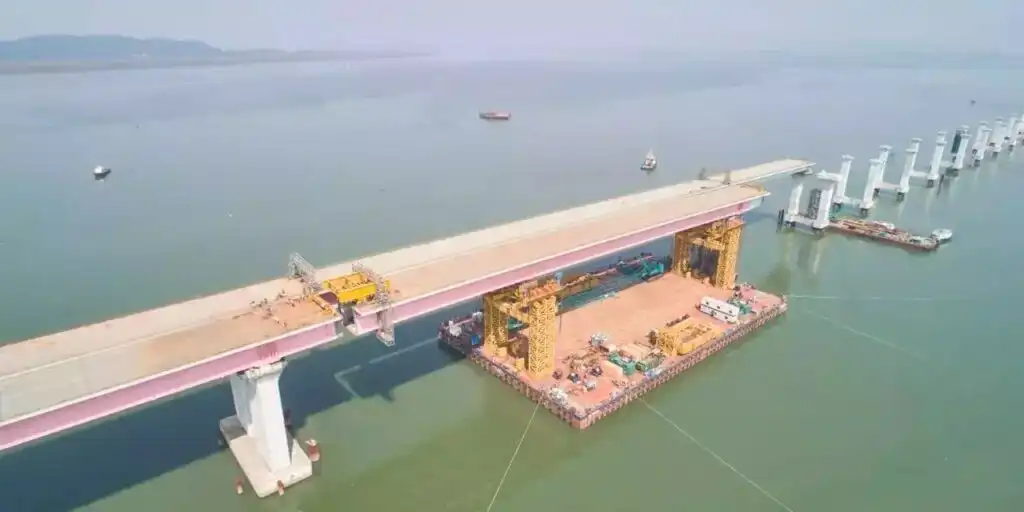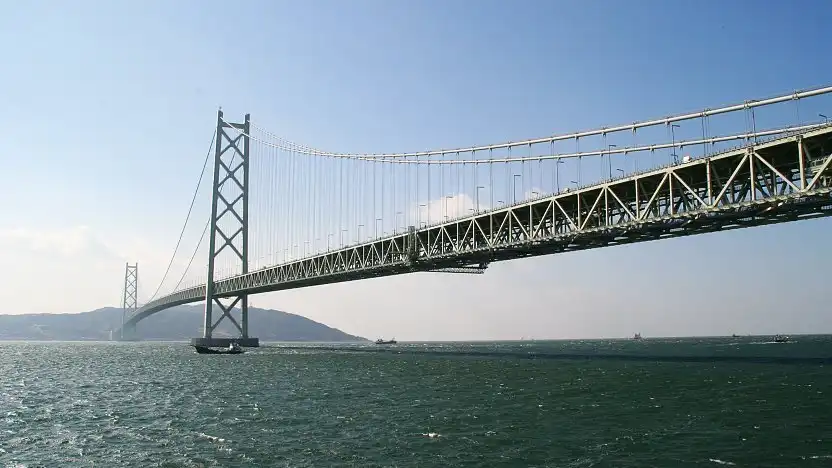The bridge decks are a critical component for the construction of bridges. The bridge decks as the roadway surface for vehicles and pedestrians and bear the load from moving vehicles. Different types of bridge decks are being erected across the world. Orthotropic steel bridge deck is one of its kind bridge deck used for bridge construction. It is a specific type of bridge deck where steel plates are used as the primary load-carrying element. In an orthotropic bridge deck, the steel plates are arranged in a transverse direction and are stiffened by longitudinal and transverse ribs or beams. The deck has lesser self-weight than concrete or composite girders. Orthotropic bridge decks are prefabricated and their modular form allows for faster erection and higher quality control.
Orthotropic steel bridge deck components
Orthotropic steel bridge decks can be divided into several sections or components based on their structural layout.
Main Deck Section: This section forms the majority of the steel deck surface and is composed of interconnected steel deck panels. The main deck section extends across the entire width and length of the bridge or structure, providing a continuous driving or walking surface.
Transverse Diaphragms: Transverse diaphragms are horizontal structural elements that connect the steel deck panels along the width of the deck. These diaphragms enhance the structural integrity of the deck system, provide rigidity, and help distribute loads more efficiently.
Longitudinal Beams or Stringers: Longitudinal beams or stringers are typically positioned underneath the steel deck panels and run parallel to the length of the bridge or structure. They provide support and distribute the loads from the deck surface to the supporting girders or beams.
Edge Beams or Copings: Edge beams or copings are located along the sides of the steel deck. They serve as a containment feature, preventing vehicles or pedestrians from inadvertently veering off the deck surface. Edge beams also provide lateral support and contribute to the overall stability of the deck system.
Bearing Plates: Bearing plates are placed at the ends of the steel deck panels where they rest on the supporting girders or beams. These plates facilitate the transfer of loads from the deck to the supporting structure while allowing for movement and expansion due to temperature variations.
Expansion Joints: In larger bridge structures or long-span decks, expansion joints are incorporated to accommodate thermal expansion and contraction of the deck. Expansion joints allow the deck to expand and contract without inducing excessive stresses or damage to the structure. They are typically positioned at intervals along the length of the deck.
These components work together to form a cohesive and robust orthotropic steel deck system. The specific configuration and design of the sections may vary depending on the project requirements, bridge type, span length, anticipated loads, and other factors considered during the design process.

Orthotropic steel bridge deck ribs
Ribs play a crucial role in the functioning and performance of orthotropic steel decks. serve as stiffening elements that enhance the load distribution capabilities of the structure. They help transfer the applied loads, such as traffic loads, to the supporting members of the bridge, such as the longitudinal girders. By distributing the loads more evenly, ribs help prevent localised stress concentrations and reduce the risk of structural failure. The presence of ribs in orthotropic steel decks improves their overall behaviour and performance. Ribs can enhance the deck’s resistance to vibrations, increase its natural frequencies, reduce unwanted lateral movements and enhance structural stability.
Orthotropic steel deck can incorporate open and closed ribs, which refer to the arrangement and design of the longitudinal ribs within the deck structure.
1. Open Rib System: In an open rib system, the longitudinal ribs in the deck structure are typically open at the bottom. This means that the space between the ribs remains open, allowing for visibility and accessibility beneath the deck. Open rib systems are commonly used in situations where access for inspection, maintenance, or utility installations is required.
2. Closed Rib System: In a closed rib system, the space between the longitudinal ribs is filled or enclosed, creating a solid structure. Closed rib systems may feature a solid plate or concrete infill between the ribs, forming a solid deck surface. The types of ribs are typically used in situations where a completely solid and continuous deck surface is desired.
Both open and closed rib systems have their respective advantages and considerations. The choice between these systems depends on various factors, including project requirements, accessibility needs, load-bearing capacity, construction methods, and aesthetic preferences.
Advantages of Orthotropic steel bridge decks
- Provide structural efficiency by creating a continuous and integrated system with supporting girders or beams. This integration enhances load distribution, reduces deflection, and improves overall structural stability.
- Steel is known for its high strength-to-weight ratio, allowing orthotropic steel decks to bear heavy loads while minimising the weight of the structure. This advantage is particularly crucial in bridge construction, where the deck needs to support the weight of vehicles, pedestrians, and other dynamic loads.
- The steel deck panels can be prefabricated off-site, allowing for faster construction and reduced on-site labour requirements. This efficiency can help accelerate project timelines.
- Enables engineers to create various deck profiles and shapes to suit specific project requirements. This adaptability allows for customised solutions, accommodating different spans, curvature, or aesthetic considerations.
- Provide enhanced resistance to lateral forces, such as wind or seismic activity. The integrated nature of the deck system, along with its connection to the supporting structure, improves overall stability and reduces the vulnerability to these forces.
- Provide a smooth and safe driving or walking surface, ensuring good traction for vehicles and pedestrians. They can also incorporate additional safety features like anti-skid coatings.
- Reduces the overall dead load of the bridge, allowing for longer spans and reducing the number of piers or supports required. This potential for lightweight construction can lead to cost savings in materials, foundation work, and construction time.
- The directional properties of orthotropic steel decks make them highly resistant to fatigue and repeated loading cycles. This is crucial in bridge applications where the deck is subjected to continuous traffic loads over its lifespan.
- Provides excellent skid resistance, which is crucial for ensuring vehicle and pedestrian safety on bridges. The surface of the deck can be treated with anti-skid materials
- Can be designed with surface treatments that enhance skid resistance and improve traction for vehicles..
Erection method of orthotropic steel bridge decks
For the orthotropic steel deck erection method the steel deck panels are positioned and attached directly to the steel beams or girders of the bridge, creating a structural system where the deck and the supporting members work together.
1. Preparation: The steel beams or girders are already in place, and any necessary temporary supports or falsework systems have been installed to provide stability during construction.
2. Panel positioning: The panels are carefully aligned and placed directly on top of the steel beams or girders.
3. Attachment: Once the panels are correctly positioned, they are securely attached to the supporting steel members. This can be done using various methods such as welding, bolting, or a combination of both. Welding is a common method for attaching deck panels, as it provides a strong and durable connection.
4. Edge and joint connections: Special attention is given to the edge and joint connections between the steel deck panels. These connections must be properly designed and constructed to ensure structural integrity and minimize the risk of cracking or displacement.
5. Finishing: After the deck panels are securely attached, additional work may be done to complete the bridge deck. This can include installing reinforcement bars, pouring concrete overlays, applying waterproofing membranes, and adding any necessary expansion joints.
Specific construction details and techniques may vary depending on the bridge design, project requirements, and local building codes.
Consulting with a qualified structural engineer and adhering to relevant construction standards and guidelines are essential for ensuring the successful implementation of the orthotropic steel deck erection method.

Orthotropic steel bridge decks in India
Mumbai Metropolitan Region Development Authority (MMRDA) launched India’s first Orthotropic Steel Deck (OSD) for Mumbai Trans-Harbour Link (MTHL) project. The first longest OSD of package-2 of about 22 km long Trans-Harbour link between Mumbai and Navi Mumbai is 180 meters long and weighs 2300 metric tonnes. On May 9, 2023, the erection of last orthotropic steel decks (OSDs) on supporting piers was completed.



Orthotropic steel bridge decks used for Mumbai Trans-Harbour Link (MTHL) project
Orthotropic steel bridge decks across the world
Though orthotropic steel bridge deck has been used for the first time in India, but the bridge deck type has been used across bridges in the world. The Millau Viaduct, cable-stayed bridge of Millau, France has the largest orthotropic steel deck area of any single bridge. Other examples include Akashi Kaikyō Bridge, Japan Lions Gate Bridge, Vancouver, Golden Gate Bridge, San Francisco, Forth Road Bridge Scotland, Second Severn Crossing, UK, Confederation Bridge, Canada etc.



Conclusion
Discussed above are the different components, advantages and application methods of orthotropic steel bridge decks.
Image Source: shortspansteelbridges.org, canambridges.com, JICA India, infra.economictimes.indiatimes.com, japan-guide.com, structure.net


